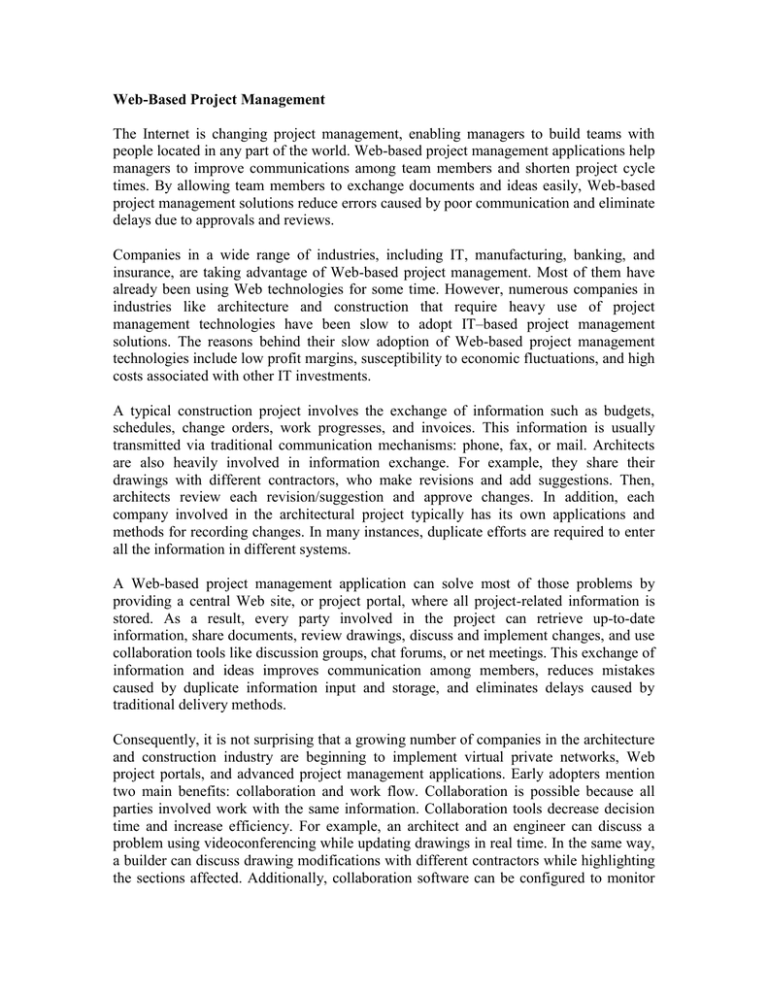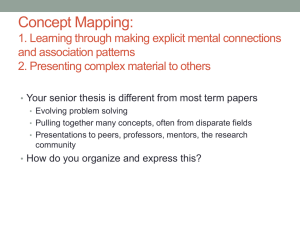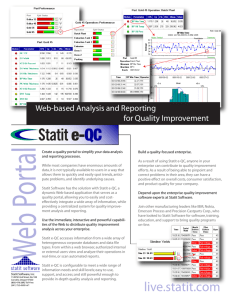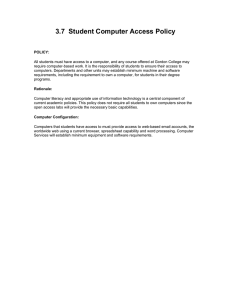Web-Based Project Management
advertisement

Web-Based Project Management The Internet is changing project management, enabling managers to build teams with people located in any part of the world. Web-based project management applications help managers to improve communications among team members and shorten project cycle times. By allowing team members to exchange documents and ideas easily, Web-based project management solutions reduce errors caused by poor communication and eliminate delays due to approvals and reviews. Companies in a wide range of industries, including IT, manufacturing, banking, and insurance, are taking advantage of Web-based project management. Most of them have already been using Web technologies for some time. However, numerous companies in industries like architecture and construction that require heavy use of project management technologies have been slow to adopt IT–based project management solutions. The reasons behind their slow adoption of Web-based project management technologies include low profit margins, susceptibility to economic fluctuations, and high costs associated with other IT investments. A typical construction project involves the exchange of information such as budgets, schedules, change orders, work progresses, and invoices. This information is usually transmitted via traditional communication mechanisms: phone, fax, or mail. Architects are also heavily involved in information exchange. For example, they share their drawings with different contractors, who make revisions and add suggestions. Then, architects review each revision/suggestion and approve changes. In addition, each company involved in the architectural project typically has its own applications and methods for recording changes. In many instances, duplicate efforts are required to enter all the information in different systems. A Web-based project management application can solve most of those problems by providing a central Web site, or project portal, where all project-related information is stored. As a result, every party involved in the project can retrieve up-to-date information, share documents, review drawings, discuss and implement changes, and use collaboration tools like discussion groups, chat forums, or net meetings. This exchange of information and ideas improves communication among members, reduces mistakes caused by duplicate information input and storage, and eliminates delays caused by traditional delivery methods. Consequently, it is not surprising that a growing number of companies in the architecture and construction industry are beginning to implement virtual private networks, Web project portals, and advanced project management applications. Early adopters mention two main benefits: collaboration and work flow. Collaboration is possible because all parties involved work with the same information. Collaboration tools decrease decision time and increase efficiency. For example, an architect and an engineer can discuss a problem using videoconferencing while updating drawings in real time. In the same way, a builder can discuss drawing modifications with different contractors while highlighting the sections affected. Additionally, collaboration software can be configured to monitor possible problems. For example, the application can send an automatic e-mail notification to the appropriate people if a task is completed, if a schedule is not met on time, or if costs are too high. Work flow allows the creation of a digital record on each project-related document. Because everybody works with the same documents, it is possible to store information concerning who makes requests and updates, from which location a user had access to the information, and at what time. This data is important to guarantee the integrity of the information and to avoid misunderstandings. Work flow also reduces project cycle time because an online application, in which documents are sent automatically to the appropriate people, can provide an ordered way to approve and reject documents. ADD Inc., a Massachusetts-based architectural firm, has used project Web sites to complete a project that involved clients in Boston and the midwest, a lawyer in Chicago, and consultants in several U.S. locations. ADD maintains that the project portal helped cut travel expenses and reduced the length of the project. Kohn Pederson Fox Associates PC, a New York firm, recently set up a virtual private network (VPN) to connect its offices in London, Tokyo, and some temporary locations. The firm had to implement the VPN to host its Web-based project management, which improved the communication between architects in different countries. Two of the most commonly used software programs for online project management are Microsoft Project and OnProject. Both programs offer similar capabilities, including permission levels, automatic e-mail notification, customized reports, Gantt charts, and critical path indicators.




